Developmental single-cell transcriptomics of hypothalamic POMC neurons reveal the genetic trajectories of multiple neuropeptidergic phenotypes
- PMID: 35044906
- PMCID: PMC8806186
- DOI: 10.7554/eLife.72883
Developmental single-cell transcriptomics of hypothalamic POMC neurons reveal the genetic trajectories of multiple neuropeptidergic phenotypes
Abstract
Proopiomelanocortin (POMC) neurons of the hypothalamic arcuate nucleus are essential to regulate food intake and energy balance. However, the ontogenetic transcriptional programs that specify the identity and functioning of these neurons are poorly understood. Here, we use single-cell RNA-sequencing (scRNA-seq) to define the transcriptomes characterizing Pomc-expressing cells in the developing hypothalamus and translating ribosome affinity purification with RNA-sequencing (TRAP-seq) to analyze the subsequent translatomes of mature POMC neurons. Our data showed that Pomc-expressing neurons give rise to multiple developmental pathways expressing different levels of Pomc and unique combinations of transcription factors. The predominant cluster, featured by high levels of Pomc and Prdm12 transcripts, represents the canonical arcuate POMC neurons. Additional cell clusters expressing medium or low levels of Pomc mature into different neuronal phenotypes featured by distinct sets of transcription factors, neuropeptides, processing enzymes, cell surface, and nuclear receptors. We conclude that the genetic programs specifying the identity and differentiation of arcuate POMC neurons are diverse and generate a heterogeneous repertoire of neuronal phenotypes early in development that continue to mature postnatally.
Keywords: POMC; development; developmental biology; hypothalamus; mouse; neuroscience; single-cell transcriptomics.
© 2022, Yu et al.
Conflict of interest statement
HY, MR, ML No competing interests declared
Figures


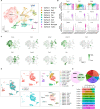

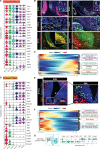


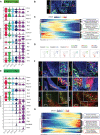



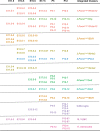



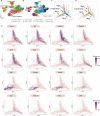

Similar articles
-
Comparative Transcriptomic Analyses of Developing Melanocortin Neurons Reveal New Regulators for the Anorexigenic Neuron Identity.J Neurosci. 2020 Apr 15;40(16):3165-3177. doi: 10.1523/JNEUROSCI.0155-20.2020. Epub 2020 Mar 25. J Neurosci. 2020. PMID: 32213554 Free PMC article.
-
The transcriptional regulator PRDM12 is critical for Pomc expression in the mouse hypothalamus and controlling food intake, adiposity, and body weight.Mol Metab. 2020 Apr;34:43-53. doi: 10.1016/j.molmet.2020.01.007. Epub 2020 Jan 11. Mol Metab. 2020. PMID: 32180559 Free PMC article.
-
Heterogeneity of hypothalamic pro-opiomelanocortin-expressing neurons revealed by single-cell RNA sequencing.Mol Metab. 2017 Mar 1;6(5):383-392. doi: 10.1016/j.molmet.2017.02.007. eCollection 2017 May. Mol Metab. 2017. PMID: 28462073 Free PMC article.
-
POMC Neurons: From Birth to Death.Annu Rev Physiol. 2017 Feb 10;79:209-236. doi: 10.1146/annurev-physiol-022516-034110. Annu Rev Physiol. 2017. PMID: 28192062 Free PMC article. Review.
-
Understanding the aging hypothalamus, one cell at a time.Trends Neurosci. 2022 Dec;45(12):942-954. doi: 10.1016/j.tins.2022.10.004. Epub 2022 Oct 19. Trends Neurosci. 2022. PMID: 36272823 Free PMC article. Review.
Cited by
-
Age, sex, and cell type-resolved hypothalamic gene expression across the pubertal transition in mice.Biol Sex Differ. 2024 Oct 24;15(1):83. doi: 10.1186/s13293-024-00661-9. Biol Sex Differ. 2024. PMID: 39449090 Free PMC article.
-
The homeodomain transcription factor Six3 regulates hypothalamic Pomc expression and its absence from POMC neurons induces hyperphagia and mild obesity in male mice.Mol Metab. 2024 Sep;87:101993. doi: 10.1016/j.molmet.2024.101993. Epub 2024 Jul 16. Mol Metab. 2024. PMID: 39025297 Free PMC article.
-
Maternal dietary fat during lactation shapes single nucleus transcriptomic profile of postnatal offspring hypothalamus in a sexually dimorphic manner in mice.Nat Commun. 2024 Mar 16;15(1):2382. doi: 10.1038/s41467-024-46589-x. Nat Commun. 2024. PMID: 38493217 Free PMC article.
-
Cannabis Sativa targets mediobasal hypothalamic neurons to stimulate appetite.Sci Rep. 2023 Dec 27;13(1):22970. doi: 10.1038/s41598-023-50112-5. Sci Rep. 2023. PMID: 38151493 Free PMC article.
-
Characterization of Hypothalamic MCH Neuron Development in a 3D Differentiation System of Mouse Embryonic Stem Cells.eNeuro. 2022 Apr 26;9(2):ENEURO.0442-21.2022. doi: 10.1523/ENEURO.0442-21.2022. Print 2022 Mar-Apr. eNeuro. 2022. PMID: 35437265 Free PMC article.
References
Publication types
MeSH terms
Substances
Associated data
- Actions
- Actions
Grants and funding
LinkOut - more resources
Full Text Sources
Molecular Biology Databases
Miscellaneous

